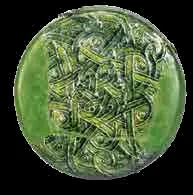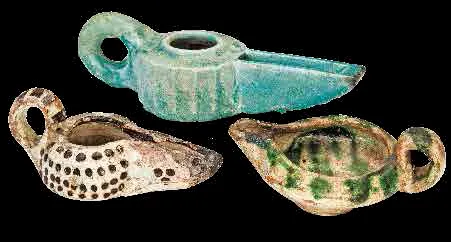
During the 12th—the early 13th centuries, the quality of everyday glazed ceramics significantly deteriorated, the clay becomes heavier, the ornament is simplified. Obviously, the restoration of dishes was associated with a decline in the living standards of the population of Mavarannahr, with the ruralization of the economy in this period. Polychrome ceramics of the 12th century are characterized by brown, red-brown, green bleeding paintings, supplemented with scratched ornament, under glaze in varying yellow (in imitation of lustre).
Monochrome ceramics under green and turquoise glaze are widely distributed; according to researchers, they were made in imitation of Chinese celadon products. This kind of glaze was also used in dishes made of kashin (semi-faience), which was lighter than clay. This silicate material was invented by Iranian masters and was first used for the production of expensive items. A kashin lamp under turquoise glaze from the collection of the Hermitage has the characteristic shape for Samarkand items of the 11th century – a cup with a projecting handle and a high leg with a saucer.
You can learn more about the topic in the book-album "Collection of the State Hermitage Mavarannakhr Art 8th – 15th centuries" (XV volume) from the series "Cultural Legacy of Uzbekistan in the World Collections".
The main sponsor of the project is the oilfield services company Eriell-Group.

